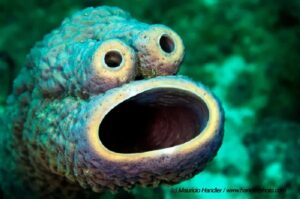The ocean hides many secrets and mysteries in its depths. Among the most amazing inhabitants of this world, sea sponges are of particular interest.
Beneath the surface of the ocean, a world of wonders unfolds, and among its humble inhabitants are sea sponges. Often overlooked, these intriguing organisms hold a trove of facts that shed light on their diversity, behavior, and essential role in marine ecosystems. This article delves into the captivating world and facts about sea sponges, from their various species and unique characteristics to their diet, reproductive strategies, and the surprising existence of sea sponge eyes.
Diversity of Sea Sponge Species: Natural Sea sponges, belonging to the phylum Porifera, boast an impressive diversity with over 8,500 identified species. Ranging from tube-shaped to encrusting forms and vibrant colors, each species contributes to the rich tapestry of life beneath the waves.
Sea Sponges as Animals: Despite their plant-like appearance, sea sponges are indeed animals. Classified as simple multicellular organisms, they lack organs and tissues, with their bodies organized into intricate channels and chambers that facilitate water circulation.
What Sea Sponges Eat: Sea sponges are filter feeders, relying on a diet of microscopic particles present in the water. These particles include bacteria, organic matter, and detritus. Water is drawn into the sponge through specialized pores, and as it circulates through the intricate network of channels, choanocytes (specialized cells) trap and consume the food particles. This process ensures a continuous supply of nutrients vital for the sponge’s survival.
Reproductive Strategies of Sea Sponges: Sea sponges employ both asexual and sexual reproduction strategies, showcasing their adaptability in diverse marine environments.
- Asexual Reproduction: A common method is budding, where small outgrowths, known as buds, form on the parent sponge. These buds eventually detach and develop into independent sponges.
- Sexual Reproduction: Sea sponges release sperm and eggs into the water, allowing fertilization to occur externally. The resulting larvae, called amphiblastula, are free-swimming before settling on a substrate and maturing into new sponges.
Sea Sponge Eyes — A Surprising Discovery: While sea sponges lack complex sensory organs, some species exhibit rudimentary eyespots or light-sensitive cells. These eyespots, also known as ocelli, enable sea sponges to detect changes in light intensity. Although not comparable to the sophisticated eyes of more complex organisms, the presence of eyespots suggests a basic ability to perceive their surroundings.
Conclusion: Sea sponges, with their diverse species, animal classification, and fascinating characteristics, play a crucial role in maintaining the health and balance of marine ecosystems. From their unique feeding methods and reproductive strategies to the surprising existence of rudimentary eyes, sea sponges continue to intrigue scientists and marine enthusiasts alike. Appreciating these often-overlooked creatures is a reminder of the intricate wonders hidden beneath the ocean’s surface, urging us to explore and understand the secrets of the deep blue.












Оставить коммент.